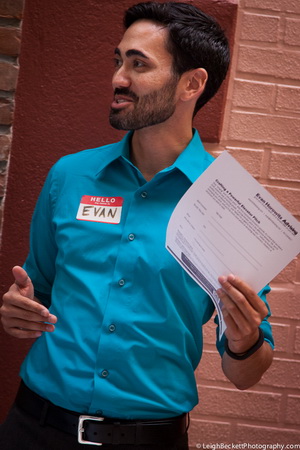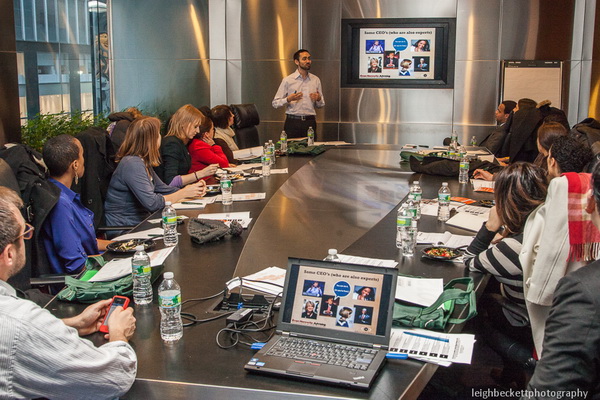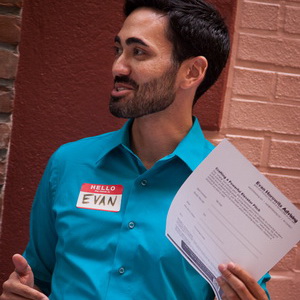
When a partner of mine turned me to on to speaking & workshops, things turned a corner. Now I showcase my expertise to packed rooms, and I typically leave with a handful of people asking to work with me. Leads from speaking are much more valuable than normal leads, because they already have a first-hand experience of your skills. Closing the sale is therefore way easier.
Over the past few years, I’ve helped many of my clients use speaking to grow the quantity and quality of their client base. Here are the basics to get you started!
[margin20]
How to Find an Audience
The first step in doing speaking and workshops is to find an audience. When I first started, my own network and email list were not large enough to fill a room. If you’re in the same boat, don’t worry.
Get going quickly by partnering with people who already have an audience. People who run events are LOOKING for experts to come in and educate their groups. Look for people running networking groups, conferences, trade associations, and the like. These guys have to fill up their calendars with interesting programs for their members! The way this typically works is that you do the talk for free, in exchange for the exposure. It’s a win-win.
Start telling your network that you do talks and workshops, and ask who they know who might be looking for speakers. Look for groups that have a lot of your ideal clients. For example, if you’re a personal trainer, you could find events about nutrition and health. Or identify groups that have your demographic, maybe it’s PTA meetings or the local running club.
Over time, finding gigs becomes easier and easier. Every time I do a workshop now, people in the audience connect me with other groups to do the same workshop. With this kind of introduction, you’ll reach new and bigger audiences.
Just be patient. Early on, I had events where nobody showed up! I learned from them and refined my process.
[margin20]
What to Talk About
First of all: YOUR TALK IS NOT A SALES PITCH. If you get up there and do an overview of your firm and your services, you deserve the tomatoes that will get thrown at you.
Your talk should educate your audience and provide real value. Share your expertise…yes, for free! Why? Because when the audience gets a taste of how good you are, those who are ready will be eager to hire you for more. Trust me; I’ve seen it time and again in my business and my clients’ businesses.
When I’m teaching my clients about this, they often get overwhelmed about putting together their talk. If you’re used to going to events filled with experts in your field, you think a talk needs to be about something innovative and cutting edge. Far from it. You’re NOT addressing experts in your field; you’re talking to your ideal clients.
Here’s the secret. The best talk addresses the rookie questions that new clients have when they come to you. What are the questions you answer all the time? They may be boring to you, but this is what potential clients are hungry to learn. And it’s great news, because putting together the talk should NOT involve new research or study; it should be easy.
The most important part of the talk is your title. People use the title to decide whether to actually show up. Horrible (and horribly common) titles are esoteric or trite. I see workshop titles like “Developments in Healthcare Legislation” and “Corporate Branding.” Who’s going to come to that?
A good title either (1) promises a solution for a problem your ideal clients feel, or (2) offers a result they’d like to see. For example, two of my most popular talks are titled: “Ugh! Prospects Don’t Understand How Awesome We Are,” and “Four Secrets to Faster & Smarter Business Growth.”

[margin20]
Collect Leads at the End of Your Talk
After you’ve spent some time sharing your incredible knowledge with your audience, some of them will be very curious about hiring you. Use the last 5-10 minutes of your talk to give a brief overview of your work. Explain what it looks like to work with you, and be sure to share a few testimonials or success stories. Tell them what the next step would be to explore working together (eg, a phone call, a consultation, etc.).
Pass out an “Information Request” form to allow people to request the next step. Be sure to include an option to opt-in to your email newsletter.
Done right, you’ll walk out of each speaking gig with three things:
[fancy_list style=”star_list” variation=”blue”]
- Lots of new signups for your newsletter.
- A few HIGHLY qualified prospective clients, asking to work with you.
- More invitations to speak for new audiences.
[/fancy_list]
[margin30]
Share Your Tips
What advice do you have for using speaking to grow your client base? Share your ideas and successes by posting a comment below!
